Have you ever watched a professional archer shoot a brilliant set of arrows, and wondered how they did it? We asked five top archers how they started in archery, which steps helped them reach such high levels, and what advice they offer up-and-coming archers.
JACOB WUKIE – USA: RECURVE
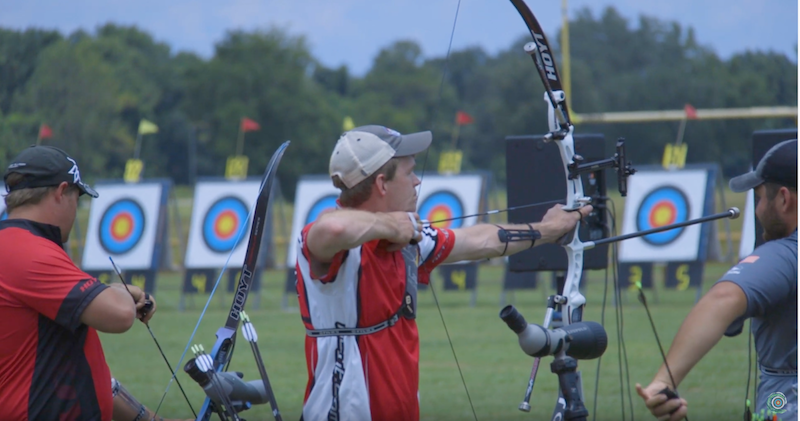
Jacob Wukie takes the line at the 2019 Gator Cup. Photo Credit: Shore Shot Archery YouTube
- When did you realize you wanted to get into archery?
I did a lot of hunting, fishing, trapping, camping, etc. From a young age I wanted to learn to shoot archery so I could bowhunt. Somewhere around my early teenage years I shot my first 3D competition, and very much enjoyed it. I became very competitive in 3D archery, eventually became interested in the Olympics, got a recurve bow to start down that path, and made the switch to Olympic style archery when I went to college.
- Where did you practice? Was it a large facility or smaller range?
I did almost all my practice in the backyard until I went to college. I also had 24-hour access to a small indoor range 45 minutes away. I used that periodically during winter, or if I needed to shoot at night. I also shot in winter leagues. Even during winter, I did most of my practice in my parents’ barn.
- How often did you practice then, and how often do you practice now?
My practice varied from a couple of sessions a week, to every day, depending on my excitement level and what I was training for. Once I became more competitive, five or six days of training weekly was normal. My training now varies considerably, depending on my work schedule and what other life events are happening. I have a four-week work schedule, so one week per month my schedule is very open. I shoot six out of seven days, and I get in 1,600 to 1,800 arrows that week. The remaining three weeks I typically get two full days and two half-days of practice when I’m in competition mode. My wife works very hard during competition season to give me time to train, so now that the season’s over I’m making a point to spend more time with her and our two daughters. I’m shooting 50 to 100 arrows two to four nights a week after the girls go to bed to keep some strength. I continue to fine-tune a few technique changes I made this year.
- What technique did you focus on when starting, and which techniques do you focus on now?
I was self-taught, and would just ask the opinion of whoever was standing closest at the time. That probably wasn’t the most productive way to get started, but I learned to analyze their techniques, which has been very valuable. Before switching to recurve, I shot compound fingers when shooting 3D archery. When I was shooting my best, I shot with a bent bow arm, straight wrist, my fingers all fully extended, only contacting the grip in the web of my hand. I held the string with my middle and index fingers, both below the nock, put my thumb behind my ear, and then twisted my string hand out away from my face until the string was about to slip. When I was ready to shoot, I would just continue that twist, and my hand would flip out away from my face. I closed my bow hand quickly to grab the bow so it wouldn’t fall. That was my shot. I did everything wrong that I could have possibly done wrong, but somehow it all worked together fairly well. Now I very much adhere to the way Coach Lee teaches technique, so depending on what area of my shot needs the most work to get closer to the way he likes, that’s what I focus on.
- What was the most important thing you learned when starting?
That I liked it. I enjoyed shooting, and getting together with people and going to tournaments.
- What do you wish someone would have told you then?
I don’t have any regrets. There are a million ways I could have been better than I was, especially in my technique. In the end, I don’t think that held me back much. The key to improving and getting to my highest level was my view that there is a right way to do every aspect of the shot. I had my opinion on what the right way was, and I worked hard to be honest enough with myself to change my opinion when I realized I might not have been seeing the whole picture.
- What steps did you take to reach the Olympic level?
My first step toward Olympic archery was when I saw a guy wearing an Olympic Trials shirt at a 3D shoot I attended. I tapped him on the shoulder and started asking questions, and he actually coordinated getting me my first recurve bow. The following year, I went to and watched the first day of the 2004 Olympic Trials. I sat down next to Rick White, who taught me a lot about the trials process, and he ended up coaching me for several years. I started training primarily with my recurve when I went to James Madison University in the fall of 2004, and learned a lot from the coaches, including Bob Ryder and Andy Puckett. While at JMU, I got introduced into competing in target archery; starting with smaller indoor competitions, then some collegiate outdoor events, and then national ranking events such as the Texas Shootout, Arizona Cup and Nationals. I made my first U.S. Archery Team in 2007, and moved out to the Olympic Training Center on July 4th, 2007. I split up my time over the next several years between finishing my degree at JMU and training at the center. I spent nearly four years training under KiSik Lee. I really applied myself in two areas: learning and applying proper technique, and physically and mentally pushing myself every day to my limit.
- What would you suggest as a competition for new archers?
Whatever competition is close and convenient. Whether it’s a local tournament or a major event, they’re all great ways to begin building your skills. Very early in my shooting, I competed in the IBO World Championships. I lost every arrow I owned, and finished the tournament with an arrow I found on the practice field, which I later returned. I’m sure I placed last, but I still had a good time, and it was a starting place. Indoor leagues are a great place to start as well. They consistently put you in a little bit of a competition mindset, and you develop some camaraderie with the people you shoot with.
- Which key skills are important to reach the Olympic level?
To compete at that level, several areas are critical.
- Mindset: You have to develop a healthy mindset. That can be tricky. Everyone is different and comes from different life experiences, so everyone will have different sticking points. There are a lot of different ideologies when it comes to mindset. Many people, while trying to be helpful, will tell you to think positive. There’s nothing wrong with that, but at the Olympic level it’s a little too simplistic. It takes more than that to learn to be excellent mentally. It’s not necessarily difficult, and it’s certainly achievable, but build your mental game on something more than other people’s well-meaning comments.
- Work Ethic and Determination: The ability to put all you have into your sport during practice and competition is not something people naturally have, and it’s not easily attainable. While I don’t have a specific recipe, some combination of striving to be the standard of hard work and determination, while training alongside others of the same mindset, is certainly a good starting point.
- Technique: Regardless of what line of thinking you buy into about technique, you have to know how to execute a good shot, arrow after arrow. I believe Coach Lee has by far figured out, more than anyone else, the best way to use the human body to execute controlled, consistent shots under pressure. I encourage every archer to apply themselves toward learning that technique the way Coach Lee teaches it.
- What do you tell new archers looking to reach the Olympic level?
You can learn from anybody. Become a student of the sport. You’ll see archers doing everything “wrong” and they’re high-level, consistent archers. You’ll see others doing everything “right” and they struggle. You can glean a lot of information from those extremes and everything in between.
It’s a great aspiration and well worth your time to pursue. That being said, I have two precautions:
- Know when it’s the right time to give it all you’ve got, to push yourself way beyond enjoyment to reach a level of excellence, and when to enjoy the sport. If you get that wrong, you can burn yourself out and lose your drive, which can be hard to get back.
- I’ll use a common phrase: If you’re not enough without the Olympics, you won’t be enough with it. Don’t make the Olympics your identity. You might very well give your entire life to it, and it becomes a big part of who you are. That’s great, but if in your mind the Olympics is what makes you “you,”that’s a recipe for disappointment.
ALEXIS RUIZ – USA: COMPOUND
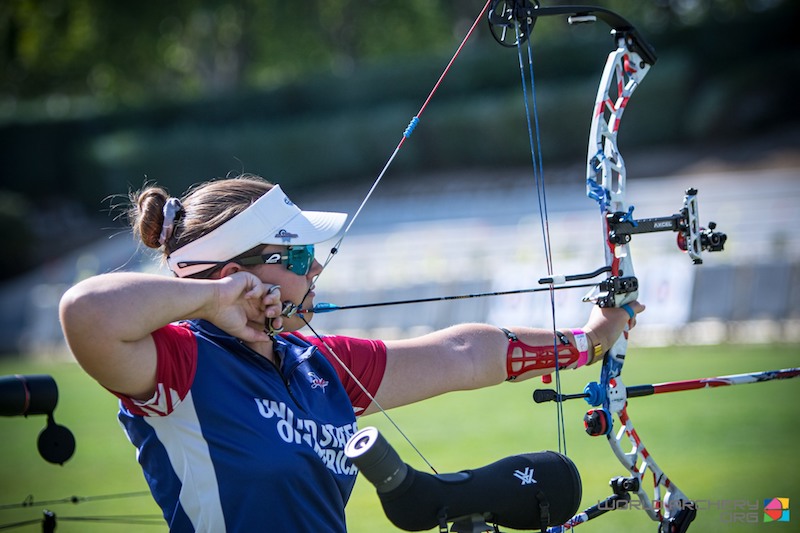
Ruiz recently took home gold at the Hyundai World Cup. Photo Credit: World Archery
- When did you realize you wanted to get into archery?
I wanted to get into archery when I was young because my dad is a bowhunter, and I wanted to bowhunt like him.
- Where did you first practice? Was it a large facility or smaller range?
I started practicing at a charter school I went to for NASP. When I got my first compound, I started shooting at a club called Corner Archery.
- How often did you practice then, and how often do you practice now?
I only practiced a couple of times a week when I started, but I practice every day and I shoot about 300 arrows now.
- What techniques did you focus on when starting, and which techniques do you focus on now?
I focused on every part of my form when I started shooting, but I focus on aiming now.
- What was the most important thing you learned when starting?
To have fun and enjoy what I’m doing.
- What do you wish someone would have told you then?
How big archery was, and how many friends I would make when I started. I had no idea how big the sport was.
- What was the best advice you received?
My mom told me to enjoy every tournament, even if I do not do as well as I hope, because I get to travel. Most people do not get to travel as much as I do.
- What steps did you take to reach the Olympic level?
I worked hard every day, and I kept my goal in my mind while practicing.
- What would you suggest as a competition for new archers?
Any local/state tournament. It will be smaller, and they can learn what tournaments feel like.
- Which key skills are most important to reach the Olympic level?
Consistency and aiming.
- What do you tell new archers looking to reach the Olympic level?
My advice is to work as hard as you can, but make sure you’re having fun because that is what this sport is about.
CRISPIN DUENAS – CANADA: RECURVE
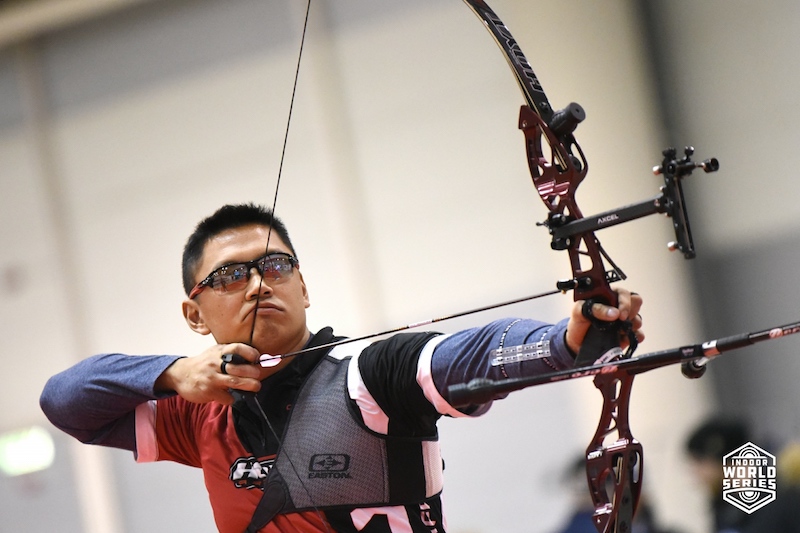
Crispin Duenas’ degree in physics helps him understand the mechanics and science behind archery. Photo Credit: World Archery
- When did you realize you wanted to get into archery?
When I was about 13 years old, and had already tried a lot of other sports. The allure of the precision of archery drew me to it, and still keeps me striving to be the best I can be.
- Where did you start practicing?
At a club northwest of Toronto called The Archers of Caledon. My first experience was with Saturday morning lessons, and I enjoyed it from Day 1. Back then I only practiced once a week because of the long drive to the club (about an hour), and also because I had to borrow their equipment.
- What techniques did you focus on when starting, and which techniques do you focus on now?
I mainly focused on having a crisp follow-through. I was coached to focus on this because it was something that, apparently, plenty of archers struggle with. I felt that was an important thing to learn from the beginning, because it was one of the longest things for me to perfect. To this day I’m always looking for ways to improve my shot, especially my release.
- What steps did you take to reach the Olympic level?
I made sure to compete in as many higher-level competitions that I could. When I was a novice, this meant I was going to the Canadian and American national championships, as well as other competitions around Canada, the U.S., and Mexico. I believe these were a great way for me to get some good experience shooting beside some of the best archers on the continent.
- What do you tell new archers looking to reach the Olympic level?
It’s not easy to get to the elite level, but when you do, you will see it was absolutely worth all the time and sacrifice you put into it. You should be willing to learn as much as you can, and go with the information that’s most relevant to you. Be as adaptive as possible. That leads to more success than being stubborn and sticking to one way of shooting or thinking.
KHATUNA LORIG – USA ARCHERY: RECURVE
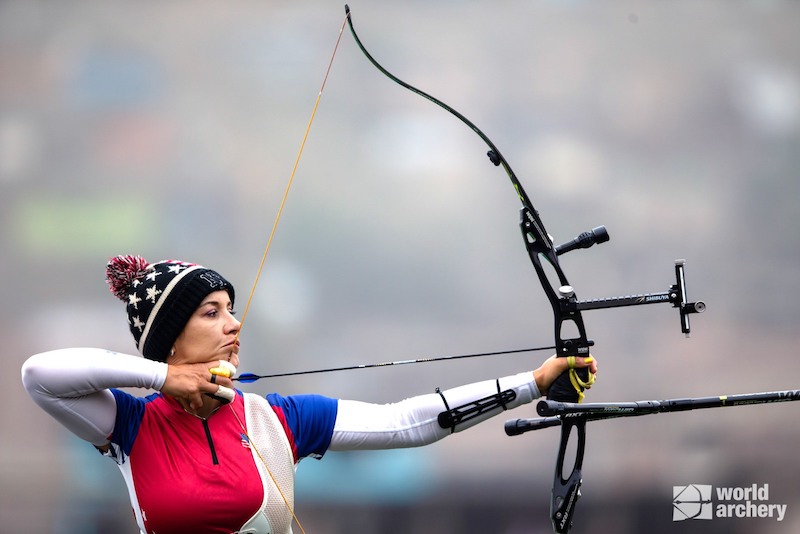
Lorig’s journey has lead her to some amazing places: the Olympics, coaching actresses, and a spot on a television commercial. Photo Credit: World Archery
- When did you realize you wanted to get into archery?
I started shooting in middle school after being recruited to the sport. I was the youngest of the group, and it was a free program that got me out of class, so I decided to go with it. I realized I wanted to stick with it at the 1992 Olympic Games in Barcelona. We ended up losing the chance to shoot for gold and took home the bronze medal. I realized I had to win, and that I cared whether we won. Archery makes me feel strong.
- Where did you first practice? Was it a large facility or smaller range?
At the facility in then-Soviet Georgia. We shared the place with other athletes, and it was always cold. We mostly shot at 30 meters. There were no safety rules enforced. If you walked out onto the range while others were shooting, you were going to get hit. It was up to you to use your common sense, and learn not to do that. When the group started out, there were 40 of us. After nine months it dwindled to six. After that I ended up being the only one who stayed with it.
- How often did you practice then, and how often do you practice now?
I practiced six days a week then and continue to practice six days a week now. When I practiced after school, I would get home at 1:30 p.m., then I would clean, do chores, go to practice at 4 and be home by 6:30. I still practice six days a week, but will sometimes take it easy if I’ve had three intensive days of training in a row. I also work out three days a week. I do lower body exercises every morning, and shoot 300 arrows every practice session. I want to make every arrow count, and I make sure I know how every arrow scored. I used to hate taking breaks to go to the doctor. Now I go to the chiropractor twice a week so they can put me back together. It’s important to listen to your body. Less is more; make sure you take breaks. Don’t shoot all day if you don’t have to. If you find it’s difficult to take time away to practice, make it a family sport and shoot together.
- What techniques did you focus on when you started, and which techniques do you focus on now?
Back tension and my posture when I hold the bow. It’s much more customized now. Coach Lee gives us clear steps on what to do, including back tension. I had no clue about it previously. It helps to know what steps you’re missing, and focus on being precise. I also focus on the mental component. In archery, you can fall from the ladder as quickly as you climbed it. An archer ranked No. 1 can lose to an archer ranked No. 64. Never underestimate an archer or a team.
- What was the most important thing you learned at the beginning?
Shoot for gold, shoot aggressively and with determination. When I was first shooting in then-Soviet Georgia, I learned to listen to the coach or get scolded. One time, the Russian head coach wanted to experiment, so they strapped us down to an electrical chair and measure our heart rate on a giant screen in a dark room. They’d make random noises in the room to startle us, and if the square measuring our heart rate hit the lines above it, we’d receive a shock, similar to a yellowjacket sting. I got better at it, so the next time they turned up the intensity. It was very intense, but it made me mentally prepared.
- What do you wish someone would have told you then?
Care less about what others are doing and concentrate on yourself. You can only help other people so much. You might just be trying to help, but they might not understand. Take one or two steps back and concentrate on yourself. Does that make sense or is it too selfish?
- What’s the best advice you received?
The question is whether I received any advice. My father told me to not forget that I was his daughter, and to not make him ashamed of me. He’s very proud of me today.
- What steps did you take to reach the Olympic level?
I quit my job and moved to Chula Vista, California, and just trained. I knew I wanted to achieve more, and that I wanted to win with Team USA. I thought that trusting Coach Lee to change my technique was a risk, but I only got better.
- What would you suggest as a competition for new archers?
Start with local competitions, and then move to state championships. Don’t jump directly into a giant competition. Make sure you’ve having fun.
- Which key skills are most important to reach the Olympic level?
Flexibility and remaining calm. Don’t show your emotions. No matter what happens, remain humble. Always smile and respect the people who admire you. Somebody is looking up to you, so behave yourself. I love kids and will always put my bow down to talk to them. They’re our future and I want to give them the best example.
- What advice do you offer new archers looking to reach the Olympic level?
Train properly and patiently to avoid injury. Make sure you respect the Olympians, and learn how to communicate with them and listen to them. Train hard; nothing will come to you on a plate. There will be pain and you’ll get frustrated, but don’t let that kill your motivation and your dreams. Acknowledge the mistakes.
JOHN DEMMER III – USA ARCHERY: BAREBOW
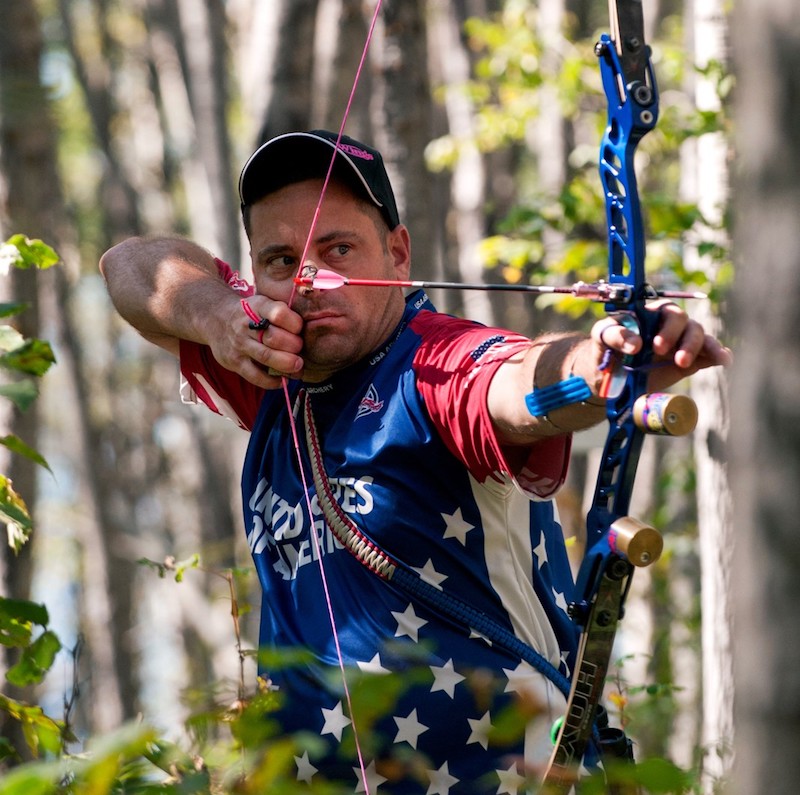
John Demmer started out competing in 3D archery, but eventually started competing in target competitions. Photo credit: World Archery
- When did you realize you wanted to get into archery?
I grew up on a farm, so everybody in my area, including my family, hunted. For the first couple of years I did nothing but hunt with a rifle. My cousin came up every year to stay with us for archery season. After talking to him about all the deer he was seeing, and how relaxing it was without many people in the woods, I started wanting to get into (bow)hunting, and get more time in the woods. There was an archery shop 15 minutes away, and I’d always go down there before hunting season to practice and get my stuff ready. I found out they had a 3D league, and they talked to me about how they go to some big 3D shoots, like the IBO Triple Crown and Worlds. They told me I should look into it, and eventually I went with him and loved it. I shot 3D for a few years, then got burned out, so I found target archery.
- Was it difficult to transition from 3D shooting to target archery?
It definitely felt different and took a little bit to transition, because it became more of a form game than 3D. The 3D targets we shot had a big 6-inch circle. The targets in target archery, depending on the tournament, can be much smaller.
- Where did you first practice? Was it a large facility or smaller range?
The place is called Deckers Bows and More, and it was the first place I trained outside of the backyard. It has an indoor 3D range and two other ranges.
- How often did you practice then, and how often do you practice now?
It all depends on whether something’s coming up. If I have a big shoot coming up and it’s important to me to be the best I can be, then I will train harder. If it’s a target national event that I love, I’ll train for three weeks leading up to it. I will overtrain the first week to build up my strength, then I will maintain strength the next two weeks and try to shoot four to five scores that week. If my body is good and my mind is good, that’s what I try to do. If I’m not feeling great, then obviously I back down the training just a little bit. If I have nothing coming up soon, then I might shoot once or twice a week. If I don’t have time for that, I generally won’t make it happen if it doesn’t come naturally.
- What techniques did you focus on when you started, and which techniques do you focus on now?
I honestly can say I had zero direction when I started. This makes me sound really old, but I started in the days where not everybody had internet. I didn’t know about online forums or anything, so everything I learned was on my own the first five to eight years.
- What was the best advice you received?
The first time I got any advice was at the first IBO Worlds I went to. I was shooting in the final day, in the final-five group, and I got some advice to lighten my poundage and shoot with three fingers. The next great advice I received was from a very good friend, Paul Vogel. He gave me some pointers on picking a good anchor point. I still use that same anchor point to this day 70% of the time. The only time I don’t is when it’s at 50 meters. Then I lower it just a little bit. Now I focus on consistent form and the shot process. There is no shortcut, but there is a predominant blueprint there, and if it’s followed, great things happen. I follow and focus on that blueprint. It never fails. Every time I deviate from it, things go subpar.
- What do you wish someone would have told you back then?
How much fun I could have doing it. I would have got into it a little bit earlier if I’d known. What I have come to love and appreciate more than anything, more than winning national championships, World Archery medals, representing the United States, more than all of that, is the lifelong bond and friendships I’ve made with some tremendous people through the years. The Vogels, the Stoners, Lyndes, Bills, Dillinger, Mozart and many others. That’s what I most appreciate in this sport.
- What steps did you take to get to the Olympic level?
Other than the couple of IBO shoots over four years, I mostly did state and regional stuff. There weren’t a lot of shooters, but it was good.
- Which key skills are the most important to reach the Olympic level?
The desire to do well, but at the same time learning to stop caring about individual arrow results. Focus on making well-executed shot after well-executed shot.
- What advice do you offer new archers looking to reach the Olympic level?
Find great archers and ask questions. Figure out what got them there and see where you’re lacking. Don’t get stuck on asking one individual, ask a few. That way you have a broader perspective and find what’s right for you. It really boils down to practice, determination, and focusing on the right things.
No matter how or where you start practicing, if you remain dedicated and participate in competitions, you’ll find success. Climb the ladder as slowly or quickly as you like, but enjoy the ride to the top.



